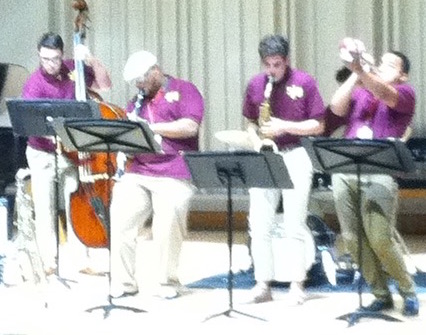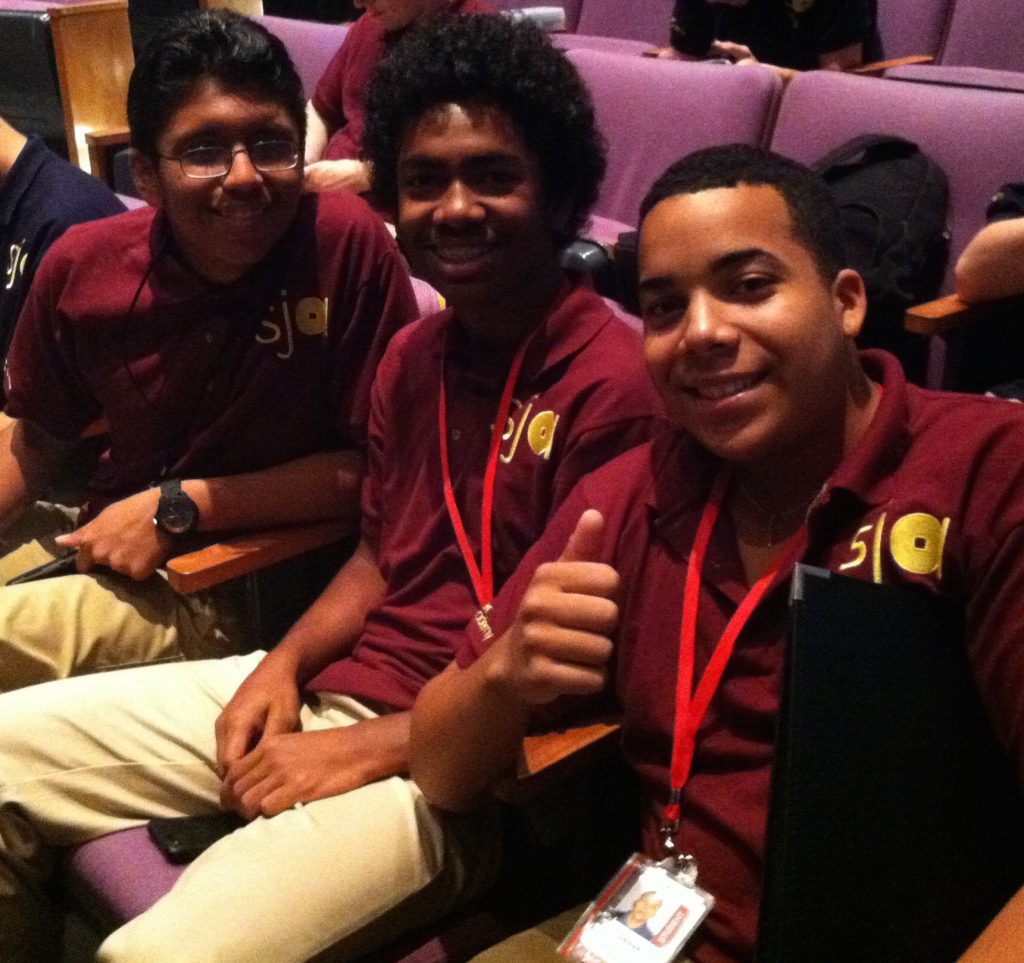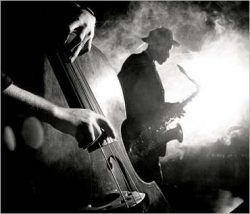Afro-Cuban culture, Blog, Cuba, Cuban Jazz, Latin Jazz, The Cuba-US connection, Video and audio
TamboThe exact origin of Machito (Francisco Raúl Gutiérrez Grillo) is a bit of mystery.
Where and when he was be born isn’t clear. Some scholars say he was born in Tampa. Others day Havana. Some put the year at 1909, others say 1912. Still others day 1915.
What isn’t a mystery is that he was raised in the Jesús María district of Havana and his foster sister Graciela (featured below) was born August 23, 1915.
What also isn’t a mystery is the impact he and his band had on world music.
Like so many accomplished musicians of that era, Machito moved to New York City (in his case in 1937) to take advantage of the opportunities in the Big Apple.
In 1940, he started his own orchestra The Afro-Cubans, one of the most important units in jazz and Cuban music history.
First, the band’s name: The Afro-Cubans.
This was a radical name for the time.
From a perspective, the term “Afro-American” was not accepted as common usage by the New York Times until 1990. So Machito and his musicians were fifty years ahead of the social curve.
Racism and the accompanying failure to acknowledge the power and virtue of African culture was as common and virulent in the Cuba of the 1930s as it was in the US.
Calling his band The Afro-Cubans was the 1940 equivalent of “We’re black and we’re proud” at a time when making such statements were rare at best and dangerous as worst.
Second, Machito’s orchestra was extraordinary by every conceivable standard and moved the art forward not only for Cuban music but for American jazz as well.
Though Dizzy Gillespie is rightly credited with helping the cause of Latin music in the US jazz world, “Manteca” wasn’t recorded until 1947 and New York City jazz musicians had been digging Machito’s music for years by then.
Also, the introduction of Dizzy Gillespie and Chano Pozo was made by another giant of Cuban music, the incomparable Mario Bauzá who was Machito’s musical partner and music director.
We’re just scratching the surface here (as we do with all these brief profiles.)
Start with these clips and dig deeper with your own research and you’ll surely be richly rewarded.
Tanga (with Zoot Sims on tenor and Symphony Sid announcing)
Machito & Graciela in Japan, 1960s– Ken McCarthy
Jazz on the Tube
P.S. Our unique programming is made possible by help from people like you. Learn how you can contribute to our efforts here: Support Jazz on the Tube
Thanks.
Afro-Cuban culture, Blog, Cuba, Cuban Jazz, Latin Jazz, Video and audio
So many great musicians, so little time.
Are you getting the sense that Cuba has produced a lot of great musicians?
Keep in mind that in this series we’re only able to show the tip of the tip of the iceberg and we’re still nowhere near covering all the ABCs.
Today we focus on the incomparable Benny Moré: singer, bandleader, composer.
Let’s start with the end: When Moré passed away at the too-early age of 43 in 1963 in Havana, over 100,000 fans attended his funeral.
Bartolomé Maximiliano Moré started life in a rural town in central Cuba. Family lore says his maternal great-great grandfather was the son of the king of a Congo tribe.
At 17, he cut sugar cane and sold fruit and medicinal herbs and used his earnings to buy his first real guitar.
Rising slowly up the show business ladder in Havana, a gig brought him to Mexico City where he changed his name to “Benny” and decide to stay awhile. In time he hooked up with Pérez Prado and appeared on 22 recordings as the singer for Prado’s orchestra.
As we’ve pointed out in the bio of Prado those were heady, prosperous days for Cuban musicians in Mexico City which in addition to being a big market unto itself was an ideal launching pad into the greater Latin American music market.
In 1952, after establishing his fame throughout the Spanish-speaking Americas, Moré returned home to Cuba where, surprisingly, he was not well known. Radio appearance and public performances helped change that.
When Moré put together his legendary Banda Gigante (Big Band) it was a near-instant hit. It was so popular that in addition to playing to sold out crowds throughout Cuba, he toured Latin America and the US where the band was invited to play at the Oscars. At home in Havana, the band dominated two of the city’s key music spots: La Tropical and El Sierra.
Though he never learned to read or write music, Moré was able to convey what he wanted to his arrangers by singing the parts to them.
After the Revolution, Moré unwilling to leave “mi gente” (my people), remained in Cuba until his death in 1963.
Note: There are a wide variety of opinions as to who the piano player is in this clip. If anyone knows for sure (fact, not opinion please), we’d love to know and will publish it here.
Playlist:
1. “Me Voy Pa’ Moron”
2. “Bemberen”
3. “Tuñare”
4. “El Baile del Sillon”
5. “Montura y Caballo”
6. “Cienfuegos”
7. “Baila Mi Son”
8. “Bonito y Sabrosa”
Me Voy Pa’ Moron
Bemberen
Tuñare
El Baile del Sillon
Montura y Caballo
Cienfuegos
Baila Mi Son
Bonito y Sabrosa
– Ken McCarthy
Jazz on the Tube
P.S. Our unique programming is made possible by help from people like you. Learn how you can contribute to our efforts here: Support Jazz on the Tube
Thanks.
Afro-Cuban culture, Blog, Cuba, Cuban Jazz, Latin Jazz, Video and audio
Pianist, drummer, singer, dancer, composer, band leader
Like many Cuban musicians, Matanzas-born Dámaso Pérez Prado left the island in search of greener commercial pastures.
In his case, he moved to Mexico City in 1949 which was experiencing an economic and social boom.
Mexico had a large motion picture industry at the time which means that Prado who was very popular had ample opportunities to have his work documented on film.
It’s a bit hard to find clips of him that are not part of elaborate Hollywood-style spectacles, but we found this one above.
The video below is example of the kind of dance and staging that accompanied his Mexican film work.
“Qué rico el mambo” aka Mambo Jambo
Lilia Prado, the popular Mexican actress and dancer (“the Mexican Marilyn Monroe”), is featured in this clip. Despite sharing a last name, she and Pérez were not married.
“Prado”, a fairly common surname, means “meadow” in Spanish.
Our young friends from Cuba play “Qué rico el mambo” at the United Place in New York City on their first trip to the US for an audience of school kids.
– Ken McCarthy
Jazz on the Tube
P.S. Our unique programming is made possible by help from people like you. Learn how you can contribute to our efforts here: Support Jazz on the Tube
Thanks.
Blog, Cuba, Cuban Jazz, Latin Jazz, Video and audio
Bebo Valdés & Diego El Cigala live
Introducing Dionisio Ramón Emilio Valdés Amaro (aka Bebo Valdés).
We’ve paid a lot of attention to the African roots of Cuban music, and rightly so.
In this video, we tip our hat to the Spanish father too.
(“Want to understand Cuba? Remember: Spanish father, African mother.”)
Of course, Spain (and Portugal) had its own African influences. In 711, a raiding force of Berbers from northwestern Africa invaded the Iberian peninsula and held various portions of it for over 700 years creating a culture unique in Europe.
In this video, Spanish cantaor (flamenco singer) Diego Ramón Jiménez Salazar (Diego el Cigala) performs with Bebo Valdés.
Who was Bebo?
Pianist, bandleader, composer, and arranger Dionisio Ramón Emilio Valdés Amaro was born on October 9, 1918 in Quivicán, Cuba a small city in the western part of the island, in the south and facing the Caribbean Sea.
He began his professional career as a pianist in Havana night clubs in the 1940s and in the 1950s was leading his own orchestra, holding down a regular slot at the Tropicana and backing singers like Benny Moré and Pío Leyva.
Valdés played an important role in adapting the mambo to the big band format (it was previously performed by charanga orchestras.)
He also created his own rhythm to compete with Pérez Prado’s mambo, which he called the batanga.
Valdés was a key player in the Afro-Cuban jazz scene in Havana and worked with producer Norman Granz to document the movement in the early 1950s.
Career rebirth
In 1960 Bebo left the island and went into exile, spending some time in Mexico and the US before eventually settling in Stockholm, Sweden to be with the love of his life there.
Off the music industry’s radar and a representative of “old” music from a country that was essentially commercially blockaded, Bebo’s work fell out of public awareness.
But his gift, continuously cultivated in Stockholm hotel piano lounges, proved to be too brilliant to be forgotten.
When he was 76, Cuban saxophone player Paquito D’Rivera produced a session with him called “Bebo Rides Again” and captured it on CD.
At 82, Fernando Trueba had the good judgement to include Bebo in the film “Calle 54” which brought his art to a new and wider audience.
When he was 85, he and Diego El Cigala recorded the album “Lágrimas Negras” (Black Tears) and toured together widely.
Here Bebo plays with a group of young Brazilian musicians in the film “The Miracle of Candeal” (El Milagro de Candeal.)
“The Miracle” is about the Brazilian favela (ghetto) of Candeal, where the young residents gave up their guns for musical instruments under the leadership of rocker Carlinhos Brown.
– Ken McCarthy
Jazz on the Tube
P.S. Our unique programming is made possible by help from people like you. Learn how you can contribute to our efforts here: Support Jazz on the Tube
Thanks.
Blog, Cuba, Cuban Jazz, Latin Jazz, The Cuba-US connection

Right to left: Jesús Ricardo (trumpet) with Hector Gagnet and Craig Jackson (both from Dayton, Ohio) and Philip Norris on bass (Wake Forest, NC.)
Will jazz survive?
The answer to this question, which lives in the hearts of all serious jazz fans, depends on two things:
Will the new generations embrace the music?
Will the established generations give the younger guys and gals a hand up?
Here’s the story of one young man’s path
Jesús Ricardo grew up in the Vedado district of Havana, Cuba.
He got his first exposure to music education when his fourth grade teacher suggested to his father that Jesús abundant energy, then used to beat rhythms on his school desk and other surfaces, might be more constructively channeled in a music program for kids. His father, a non-musician, said: “Sure, let’s give it a try.”
The focus of the training was classical, as is all institutional music education in Cuba, but the school also had as an elective a jazz big band. Hearing the band opened Jesús ears and captured his imagination. In jazz, he heard a music that would allow him not just to play, but to also express himself.
Bringing the US jazz tradition to Cuba
When he was in seventh grade, Jazz at Lincoln Center and Horns to Havana brought instructors to the island for performances and workshops. Jesús was one of the students who received training from Wynton Marsalis, Victor Goines, and Mike Rodriguez.
Students in the program were invited to sing solos and Jesús stood up and gave it a try. He along with the other students were encouraged to get that same singing feel with their instruments. When the Jazz at Lincoln Center group performed at Havana’s Teatro Nacional, Jesus was invited to come on stage and take a trumpet solo on Night in Tunisia.
In the ninth grade, Horns to Havana arranged for Jesús to spend a month in New Orleans.
Last year with help from Horns to Havana, he attended the Stanford Jazz Workshop and this summer he qualified for Jazz at Lincoln Center’s Summer Jazz Academy.
Jazz at Lincoln Center’s Summer Jazz Academy
Designed by Wynton Marsalis, who is also one of the instructors, and led by Dr. Michael Albaugh, the Academy is a two week residential program which this year was held on the campus of Bard College.
This year’s faculty included Wynton Marsalis (trumpet), Marcus Printup (trumpet), Ted Nash (saxophone, flute), Vincent Gardner (trombone), Helen Sung (piano), James Chirillo (guitar), Rodney Whitaker (bass) and Ali Jackson (drums).
(If any of these names are unfamiliar to you, get thee to Youtube, Spotify and/or the iTunes store and dig in. You won’t be disappointed. The faculty played a set as an octet and individually and as a group they were splendid.)
The program is open by audition to high school jazz students from all over the world. Only only 42 are accepted.
In addition to his growing jazz chops, Jesús is at home in Cuban idioms like Son, Guaracha and Rumba and draws inspiration from the music of Cuban trumpet greats like Chapotin and Florecita. He’s performed with the Septeto Habanero, an esteemed interpreter of the island’s classic Son repertoire.
A serious student of the tradition
When I asked Jesús who his favorite trumpet player was, he responded: “All of them. There’s something important to learn from all of them.”
As part of their training, the students worked in small groups – eight different octets in total – and at the end of Week One they offered a public performance of standards ranging from George and Ira Gershwin to Ornette Coleman.
The octet Jesús played with was tasked with King Oliver’s “Dippermouth Blues.” At first he says he worked the changes like a bebopper until Marsalis, who coached the unit, explained Oliver’s syncopated style which had been perfected by countless parades and funerals.
With Marsalis’ guidance, Jesús adapted and you could hear – and even see – the New Orleans flowing through him as he marched in place when he took his solo.
Will jazz survive?
At the start of this article I said that the answer to this question depends on two things: the younger generation’s interest and the established generation’s caring.
Things seem to be on the right track in both these departments.
If you want to learn more about groups that are helping make the next generation of jazz possible, here are two excellent places to start.
Horns to Havana
http://hornstohavana.org
Jazz at Lincoln Center
http://www.jazz.org

Jesús (right) with fellow students at the Lincoln Center Summer Jazz Academy
– Ken McCarthy
Jazz on the Tube
P.S. Our unique programming is made possible by help from people like you. Learn how you can contribute to our efforts here: Support Jazz on the Tube
Thanks.
Afro-Cuban culture, Blog, Cuba, Cuban Jazz, Latin Jazz, Video and audio
Everywhere on earth music flows from the human voice and the drum.
In Cuba, with its long and direct connections to Central Africa’s incomparable polyrhythmic virtuosity, the drums take on an especially prominent role.
The bass, the piano, even the horns have at their aesthetic root the sophisticated sounds and rhythms produced by Cuba’s percussionists.
Contrast this with northern music (Europe and North America), where drummers, percussionists, and even the issue of rhythm itself tends to be shunted to the back of the bandstand.
As a result of this hierarchical skewing, the details of drumming appear far off the radar for the person trained with a northern ear, if in fact they make it onto the radar screen at all.
Your appreciation, understanding and enjoyment of Cuban music will grow massively as you learn what the congueros (conga players) are doing and how they produce their magical sounds.
In this video two masters talk shop.
Dig in.
If you love music, I can guarantee that watching and re-watching this video will change your ear for the better and produce a lifetime of enjoyment that will surprise and delight you.
Note: The conversation is in Spanish. Reading the well produced subtitles makes for an excellent and enjoyable Spanish lesson.
Background
This masterpiece of educational video, “Evolution of the Tumbadoras”, was produced in 1996 in New York City by a company called DCI Music Videos.
The two percussionists are Changuito (José Luis Quintana) and Giovanni Hidalgo.
Changuito was born on January 18, 1948 in the Casablanca district of Havana.
By 8 he was already playing professionally at the legendary Tropical with his musician father in the thriving Cuban music scene of the 1950s.
In 1970, he joined the Cuban super group Los Van Van. Among many other accomplishments (including three Grammys) he’s known for popularizing the “songo” genre, the forerunner of the “timba” form.
Grammy award winning Giovanni Hidalgo was born on November 22, 1963 in San Juan Puerto Rico to a musical family. His father José Manuel Hidalgo “Mañengue” was also a renowned conga player.
In 1981 he traveled to Cuba as a member the Batacumbele Band where he met Changuito and 15 years later the fruit of that relationship was captured by this video.
MORE: Highlights reel – Just instruction, no conversation
Tata Guines gives a lesson
– Ken McCarthy
Jazz on the Tube
P.S. Our unique programming is made possible by help from people like you. Learn how you can contribute to our efforts here: Support Jazz on the Tube
Thanks.




